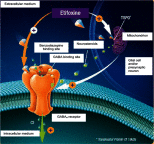An update on the anxiolytic and neuroprotective properties of etifoxine: from brain GABA modulation to a whole-body mode of action
- PMID: 31308671
- PMCID: PMC6615018
- DOI: 10.2147/NDT.S200568
An update on the anxiolytic and neuroprotective properties of etifoxine: from brain GABA modulation to a whole-body mode of action
Abstract
Treating the signs and symptoms of anxiety is an everyday challenge in clinical practice. When choosing between treatment options, anxiety needs to be understood in the situational, psychiatric, and biological context in which it arises. Etifoxine, a non-benzodiazepine anxiolytic drug belonging to the benzoxazine class, is an effective treatment for anxiety in response to a stressful situation. In the present review, we focused on several aspects of the cerebral and somatic biological mechanisms involved in anxiety and investigated the extent to which etifoxine's mode of action can explain its anxiolytic activity. Its two mechanisms of action are the modulation of GABAergic neurotransmission and neurosteroid synthesis. Recent data suggest that the molecule possesses neuroprotective, neuroplastic, and anti-inflammatory properties. Etifoxine was first shown to be an effective anxiolytic in patients in clinical studies comparing it with clobazam, sulpiride, and placebo. Randomized controlled studies have demonstrated its anxiolytic efficacy in patients with adjustment disorders (ADs) with anxiety, showing it to be superior to buspirone and comparable to lorazepam and phenazepam, with a greater number of markedly improved responders and a better therapeutic index. Etifoxine's noninferiority to alprazolam has also been demonstrated in a comparative trial. Significantly less rebound anxiety was observed after abrupt cessation of etifoxine compared with lorazepam or alprazolam. Consistent with this finding, etifoxine appears to have a very low dependence potential. Unlike lorazepam, it has no effect on psychomotor performance, vigilance, or free recall. Severe adverse events are in general rare. Skin and subcutaneous disorders are the most frequently reported, but these generally resolve after drug cessation. Taken together, its dual mechanisms of action in anxiety and the positive data yielded by clinical trials support the use of etifoxine for treating the anxiety signs and symptoms of individuals with ADs.
Keywords: 3α; 5α-THP; GABA; TSPO; adjustment disorders; allopregnanolone; anxiety; benzodiazepines; etifoxine; neuroprotection; translocator protein 18 kDa.
Conflict of interest statement
Dr. Nuss received a research grant and consultancy fees from Biocodex. The authors report no other conflicts of interest in this work.
Figures


Similar articles
-
Etifoxine versus alprazolam for the treatment of adjustment disorder with anxiety: a randomized controlled trial.Adv Ther. 2015 Jan;32(1):57-68. doi: 10.1007/s12325-015-0176-6. Epub 2015 Jan 27. Adv Ther. 2015. PMID: 25620535 Free PMC article. Clinical Trial.
-
Dissociation of endocrine responses to the Trier Social Stress Test in Virtual Reality (VR-TSST) by the benzodiazepine alprazolam and the translocator protein 18 kDa (TSPO) ligand etifoxine.Psychoneuroendocrinology. 2021 Feb;124:105100. doi: 10.1016/j.psyneuen.2020.105100. Epub 2020 Dec 5. Psychoneuroendocrinology. 2021. PMID: 33338971 Clinical Trial.
-
Efficacy of etifoxine compared to lorazepam monotherapy in the treatment of patients with adjustment disorders with anxiety: a double-blind controlled study in general practice.Hum Psychopharmacol. 2006 Apr;21(3):139-49. doi: 10.1002/hup.757. Hum Psychopharmacol. 2006. PMID: 16625522 Clinical Trial.
-
Etifoxine for pain patients with anxiety.Korean J Pain. 2015 Jan;28(1):4-10. doi: 10.3344/kjp.2015.28.1.4. Epub 2015 Jan 2. Korean J Pain. 2015. PMID: 25589941 Free PMC article. Review.
-
[Comorbid anxiety disorders in patients with neurological pathology: current state of the problem and the role of etifoxine in treatment strategy].Zh Nevrol Psikhiatr Im S S Korsakova. 2024;124(12):126-136. doi: 10.17116/jnevro2024124121126. Zh Nevrol Psikhiatr Im S S Korsakova. 2024. PMID: 39731382 Review. Russian.
Cited by
-
The neuropsychiatric manifestations of COVID-19: Interactions with psychiatric illness and pharmacological treatment.Biomed Pharmacother. 2021 Mar;135:111200. doi: 10.1016/j.biopha.2020.111200. Epub 2021 Jan 1. Biomed Pharmacother. 2021. PMID: 33421734 Free PMC article. Review.
-
Analysis of the Underlying Mechanism of the Jiu Wei Zhen Xin Formula for Treating Generalized Anxiety Disorder Based on Network Pharmacology of Traditional Chinese Medicine.Evid Based Complement Alternat Med. 2022 May 29;2022:7761852. doi: 10.1155/2022/7761852. eCollection 2022. Evid Based Complement Alternat Med. 2022. PMID: 35677384 Free PMC article.
-
Allosteric modulators of the δ GABAA receptor subtype demonstrate a therapeutic effect in morphine-antinociceptive tolerance and withdrawal in mice.Neuropharmacology. 2022 Nov 15;219:109221. doi: 10.1016/j.neuropharm.2022.109221. Epub 2022 Sep 7. Neuropharmacology. 2022. PMID: 36084794 Free PMC article.
-
Palladium-catalyzed synthesis of 4-sila-4H-benzo[d][1,3]oxazines by intramolecular Hiyama coupling.Chem Sci. 2023 Mar 22;14(15):4114-4119. doi: 10.1039/d2sc06425a. eCollection 2023 Apr 12. Chem Sci. 2023. PMID: 37063809 Free PMC article.
-
TSPO: an emerging role in appetite for a therapeutically promising biomarker.Open Biol. 2021 Aug;11(8):210173. doi: 10.1098/rsob.210173. Epub 2021 Aug 4. Open Biol. 2021. PMID: 34343461 Free PMC article. Review.
References
-
- Semaan W, Hergueta T, Bloch J, et al. [Cross-sectional study of the prevalence of adjustment disorder with anxiety in general practice]. Encephale. 2001;27(3):238–244. - PubMed
Publication types
LinkOut - more resources
Full Text Sources

